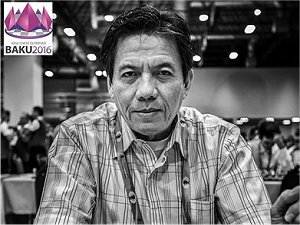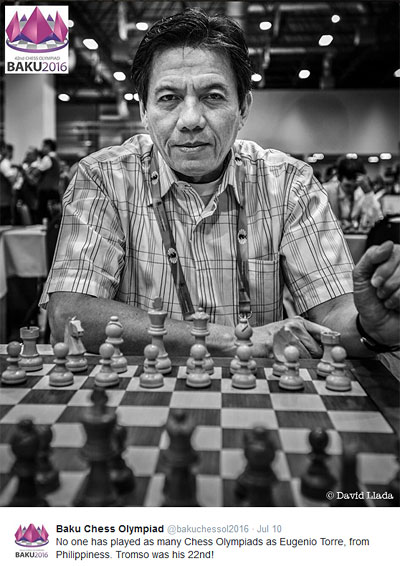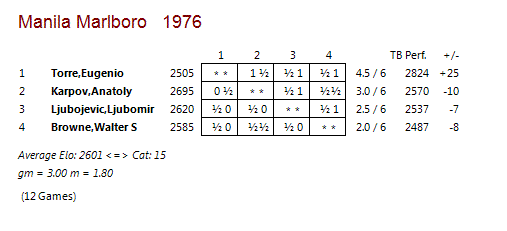


Winning starts with what you know
The new version 18 offers completely new possibilities for chess training and analysis: playing style analysis, search for strategic themes, access to 6 billion Lichess games, player preparation by matching Lichess games, download Chess.com games with built-in API, built-in cloud engine and much more.

GM Eugenio Torre from the Philippines.
Baku is his 23rd Olympiad (Photo: David Llada)
But even if Eugenio Torre had not played a single game in Chess Olympiads, he would still be a chess legend. Born on 4th November 1951 in the Philippines, Torre is Asia’s first grandmaster, paving the way for many more to come. He won the title in 1974, when he was 22 years old. Two years later, 1976, Torre created a sensation in the chess world. In the Marlboro-Loyola Kings Challenge Chess Tournament, a four-player double round-robin in Manila, he started as an outsider and as lowest-rated player, but finished clear first with 4.5/6, 1.5 points ahead of reigning World Champion Anatoly Karpov.

In one of their two games Torre beat Karpov in entertaining fashion with Black.
Inspired? Mihail Marin explains why it might be a good idea to play the Classical Sicilian.
|
After the tournament in Manila people talked about Torre as potential World Champion Candidate, but though he continued to play on a very high level and was part of the top twenty in the early eighties, he did not make it to the absolute top. In the Interzonal Tournament 1982 in Toluca he tied for first with Lajos Portisch from Hungary and qualified for the Candidate Matches but was eliminated in the quarterfinals after losing 4-6 against Zoltan Ribli from Hungary.
After this loss Torre played less and less but did a lot for chess in the Philippines. He hosted Chess Today, a daily one-hour show on TV that helped to make chess more popular in the Philippines. And in the 1992 match between Bobby Fischer and Boris Spassky in Sveti Stefan, Torre worked as a second for the American.
However, as impressive as these achievements are, it is in the Olympiads that Torre really shines. The Olympiad in Baku 2016 is his 23rd Olympiad and that is a record – no other player in the history of chess has played in more Olympiads.
Torre played his first Olympiad in 1970, in Siegen, Germany, and celebrated his debut with a first round win against Ridhu Belkadi from Tunisia.
From 1970 in Siegen in Germany to 2014 in Tromso, Norway, Torre played 252 games in the Olympiads, scoring 155.5/252 (91 wins, 119 draws, and 42 losses). 1974 in Nice, 1980 in Malta, and 1986 in Dubai, Torre won the bronze medal for the third-best individual result on board one.
In Baku Torre plays third board for the Philippines and after seven rounds has the impressive score of 6.0/7 (five wins, two draws, no losses), that amounts to an Elo-performance of 2712.
At the Olympiad in Baku Susan Polgar used the opportunity to interview the grandmaster for the official website of the Olympiad.